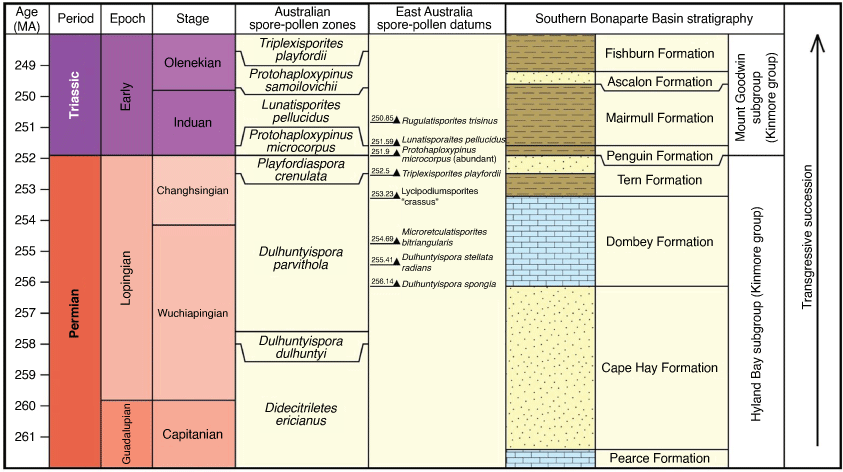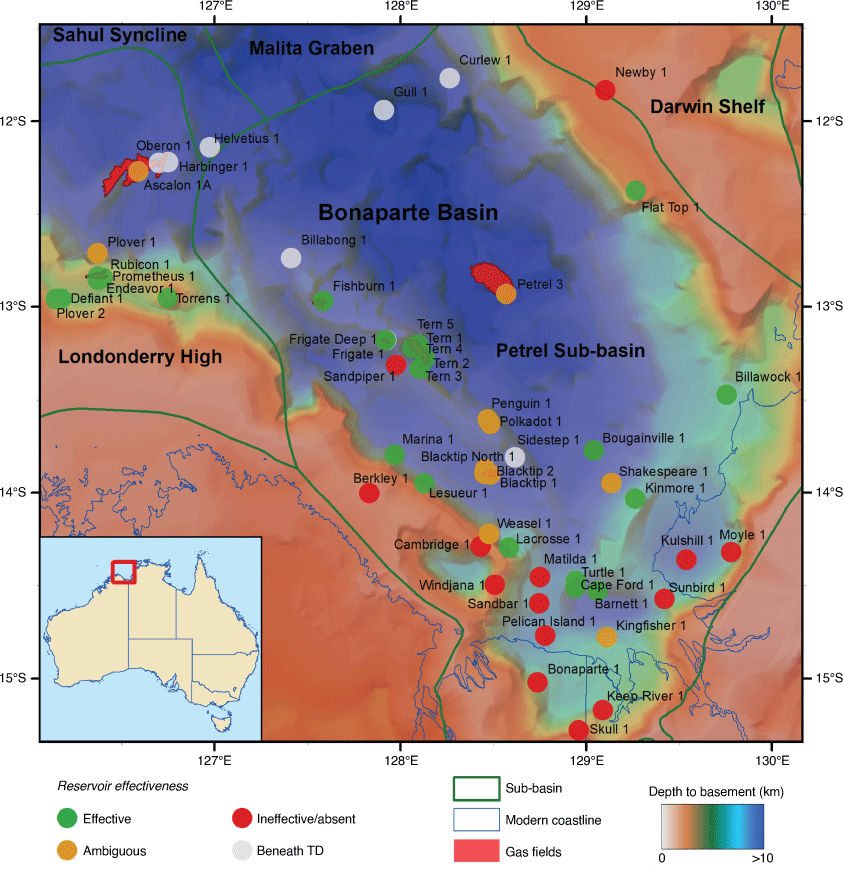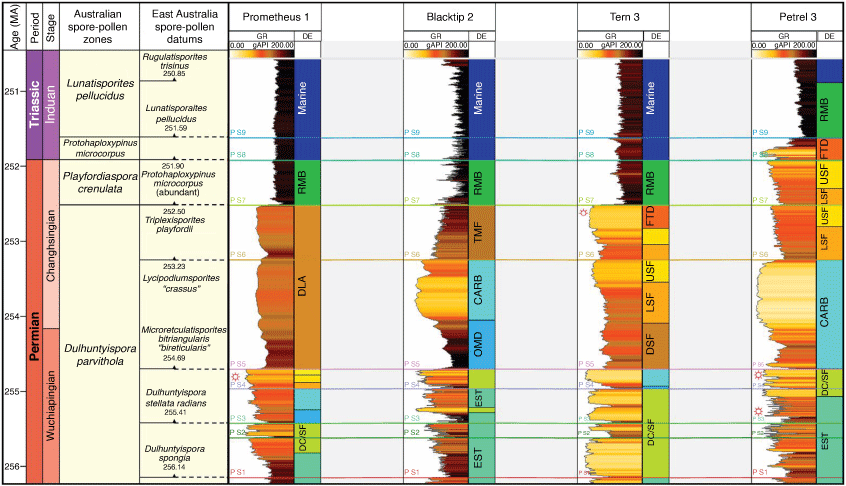Addressing exploration uncertainties in the southern Bonaparte Basin: enhanced stratigraphic control and post drill analysis for upper Permian plays
R. Owens A * , A. Kelman A , K. Khider A , J. Iwanec A and T. Bernecker AA Geoscience Australia, GPO Box 378, Canberra, ACT 2601, Australia.
The APPEA Journal 62 S474-S479 https://doi.org/10.1071/AJ21122
Accepted: 15 March 2022 Published: 13 May 2022
© 2022 The Author(s) (or their employer(s)). Published by CSIRO Publishing on behalf of APPEA. This is an open access article distributed under the Creative Commons Attribution 4.0 International License (CC BY).
Abstract
The upper Permian to lower Triassic sedimentary succession in the southern Bonaparte Basin represents an extensive marginal marine depositional system that hosts several gas accumulations, including the Blacktip gas field that has been in production since 2009. Development of additional identified gas resources has been hampered by reservoir heterogeneity, as highlighted by preliminary results from a post drill analysis of wells in the study area that identify reservoir effectiveness as a key exploration risk. The sedimentary succession that extends across the Permian–Triassic stratigraphic boundary was deposited during a prolonged marine transgression and shows a transition in lithofacies from the carbonate-dominated Dombey Formation to the siliciclastic-dominated Tern and Penguin formations. Recent improvements in chronostratigraphic calibration of Australian biostratigraphic schemes, spanning the late Permian and early Triassic, inform our review of available palynological data, and re-interpretation and infill sampling of well data. The results provide a better-resolved, consistent and up-to-date stratigraphic scheme, allowing an improved understanding of the timing, duration and distribution of depositional environments of the upper Permian to lower Triassic sediments across the Petrel Sub-basin and Londonderry High.
Keywords: biostratigraphy, Bonaparte Basin, North West Shelf, Permian–Triassic boundary, Petrel Sub-basin, post drill analysis, reservoir, stratigraphy.
Introduction
The late Permian to early Triassic stratigraphy of the southern Bonaparte Basin (SBB) includes the Hyland Bay Subgroup, which incorporates the Torrens, Pearce, Cape Hay, Dombey and Tern formations, and the overlying Mount Goodwin Subgroup that includes the Penguin, Mairmull, Ascalon and Fishburn formations (Fig. 1; Gorter 1998; Gorter et al. 2009). The Permian–Triassic stratigraphic boundary (PTB) occurs at or around the transition from the Hyland Bay Subgroup to the lowermost Mount Goodwin Subgroup. The sedimentary succession spanning this interval was deposited during a prolonged marine transgression and shows a transition from the estuarine Cape Hay Formation, to the offshore carbonate-dominated Dombey Formation, to the marginal to shallow marine siliciclastic-dominated Tern and Penguin formations.

|
Upper Permian reservoirs in the Hyland Bay Subgroup constitute the P50 play interval in the SBB (Phillips et al. 2019). The P50 play interval is generally deeply buried where it has been the target for exploration (e.g. reservoir depths of >2450 and >3550 m in the Tern and Petrel fields, respectively). The preservation of porosities and permeabilities within these reservoirs is dependent on the presence or absence of clay coatings around detrital quartz grains, which act to inhibit siliceous cementation during diagenesis (Bhatia et al. 1984; Saïag et al. 2016). Recent work shows the presence of these clay coatings is linked to the depositional environment of reservoirs (Wooldridge et al. 2019), highlighting the need for refined depositional models to reduce the risk and uncertainty for the P50 play interval.
Studies of Triassic and Permian basins in onshore and offshore Australia rely heavily on the Australian Spore-Pollen Zonation scheme that is based largely on the work of Kemp et al. (1977), Foster (1982), Helby et al. (1987), Price (1997) and Mantle et al. (2010). The chronostratigraphic calibration of these zones has been updated as a result of radiometric dating (Laurie et al. 2016; Fielding et al. 2019; Mays et al. 2020) and updates to the Geological Time Scale (Gradstein et al. 2020).
This work presents a review of the biostratigraphic data from wells that intersect the Permo-Triassic succession in the SBB, which have been supplemented with additional samples and palynological analyses. New and revised biostratigraphic data is integrated with well log interpretations and correlations to subdivide the upper Permian and lower Triassic succession into broad parasequences that record changes in lithofacies and capture the evolution of depositional environments across the basin. Aspects of the biostratigraphic review and the depositional history of the succession around the PTB in the SBB are discussed using the updated biostratigraphic control and parasequence interpretations from the field areas of Prometheus/Rubicon, Tern, Petrel and Blacktip. A post drill analysis of the upper Permian Hyland Bay Subgroup (P50 play interval) has also been undertaken to provide insights into the main play risk elements.
Results and discussion
Post drill analysis
A preliminary post drill analysis of the P50 play interval (Tern, Dombey, Cape Hay and Pearce formations) has been undertaken. The P50 play extends across much of the offshore SBB, but was either not deposited or subsequently eroded over the southern-most flanks of the Petrel Sub-basin, the Berkley Platform and the Darwin Shelf (B. Bradshaw, pers. comm., March 2022). Eleven proven or interpreted occurrences of gas have been intersected in the P50 play across the study area (Ascalon 1A, Defiant 1, Fishburn 1, Frigate Deep 1, Penguin 1, the Petrel Field, Plover 1, Polkadot 1, Prometheus 1, Rubicon 1 and the Tern Field). Successful gas tests in the P50 play interval are associated with four-way dip-closed anticlines and high-side fault-block traps.
The analysis identified that the primary risk for the P50 play is reservoir effectiveness (Fig. 2), with fault seal and hydrocarbon charge representing secondary risks. Assessment criteria for reservoir presence and effectiveness are based on geological cut-offs rather than commercial cut-offs, which are beyond the scope of this study. Results for reservoir presence and effectiveness would be markedly different if commercial considerations were included in the assessment. The P50 play has generally not been a primary or secondary exploration target, and has rarely been evaluated in detail through logging and/or testing. Our reservoir evaluation of the P50 interval is therefore largely qualitative in nature and based on available data from company well completion reports. Interpreted porosities are good to excellent (from 15% to 30%), however permeability tends to be low (in the tens to low hundreds of mD) as a result of silica and/or calcareous cements or high clay contents. At these relatively low permeabilities, commercial flow rates may be challenging, as shown by the drilling campaign of the Tern Field, which highlights reservoir effectiveness as a risk for this play.

|
Biostratigraphic review
As part of our study, MGPalaeo were contracted to review available biostratigraphic data and undertake additional sampling and analysis (Mantle and Hannaford 2021). The revised palynological data enables updating of zonal assignments. Wells included in this work were: Ascalon 1, Blacktip 2, Blacktip P1, Petrel 1A, Petrel 2, Petrel 3, Petrel 4, Petrel 5, Petrel 6, Prometheus 1, Rubicon 1, Tern 1, Tern 2, Tern 3, Tern 4, Tern 5 and Torrens 1 (Fig. 2). Palynofacies analyses were also carried out on key intervals in selected wells.
The better-resolved and updated zonal assignments allow for improved resolution of the Dulhuntyispora parvithola, Playfordiaspora crenulata and Protohaploxypinus microcorpus zones through the studied wells. The new dataset also permits the ‘APP5’ subzones of Price (1997) to be discerned in many instances. The transitions into the P. crenulata and P. microcorpus zones – of particular interest due to being synchronous with the onset of the End Permian Extinction (EPE) event and PTB in eastern Australian basins (Fielding et al. 2019; Mays et al. 2020) – are further elucidated by the palynofacies analyses.
Depositional history
In the studied wells, the upper Permian to lower Triassic succession shows a progression from the estuarine Cape Hay Formation, to the shallow marine carbonate-dominated Dombey Formation, to the siliciclastic offshore to shoreface Tern Formation sandstones, and mud basin siltstones and shales of the Penguin Formation. In detail, there is variability in the nature and arrangement of the parasequences that make up the succession, reflecting subtle differences in depositional setting and evolution. The general progression can be summarised as follows:
Deposition of the transgressive Cape Hay Formation in a protected to restricted estuarine embayment (Kloss et al. 2004). Initial sequences are largely characterised as tide-dominated sand and mud flats with a fluvial component. Upper sequences become increasingly sand-dominated, showing a stronger marine influence, as the transgression intensifies, and include tidal channel and bar complexes and sandy tidal flats (Kloss et al. 2004).
Marine flooding of the estuarine embayment and deposition of the shallow marine to shelfal carbonates of the Dombey Formation. A concurrent reduction in fluvial/terrestrial sediment input would have also been important to establish conditions that were conducive to carbonate-dominated deposition.
Resumption of siliciclastic deposition and the establishment of a progradational shoreface system across the SBB. The offshore to lower shoreface siltstones and sandstones of the lower Tern Formation indicate relatively stable eustatic sea-level conditions, with repeated filling of accommodation delivering at least two cycles that coarsen-up to upper shoreface sandstones.
Deposition of restricted mud basin deposits from the lower Penguin Formation, which represent continued progradation of the coastal and shallow marine depositional system. In the Tern wells, an intervening transitional section interpreted to represent flood tide delta and tidal channel facies is preserved in the uppermost Tern Formation (Bann et al. 2004).
Marine transgression resulting in flooding of the restricted mud basin and deposition of marine siltstone and mudstones of the upper Penguin and Mairmull formations in an open marine embayment.
Integrating high-resolution biostratigraphic control with the interpreted upper Permian to lower Triassic parasequences highlights the diachronous nature of these deposits across the SBB (Fig. 3). This indicates the parasequences and associated facies, that form the building blocks of the upper Permian and lower Triassic lithostratigraphic units, are highly sensitive to changes in balance between accommodation and sediment supply. Within the framework of a broad regional transgression during the late Permian and early Triassic, the high input of clastic coastal and fluvial sediments produced a prograding system of stacked parasequences, with the progression into coastal depositional environments occurring later in deeper basin areas. While our interpretation implies the main direction of the deepening paleo-bathymetric trend was to the northeast in the late Permian, there is also considerable lateral variation in depositional environments indicating local variations in paleo-bathymetry as well as switching in sediment sources. Spatial variability in the generation of accommodation is considered to be a contributing factor controlling the diachronous nature of the lithostratigraphic units, which reflects variations in subsidence rates across the basin potentially related to salt tectonism in the Petrel Sub-basin.

|
Conclusion
Post drill analysis of the P50 play interval across the SBB highlights that while several gas discoveries have been made, reservoir effectiveness is a key exploration risk. New and revised biostratigraphic and palynofacies data for the upper Permian and lower Triassic succession in the SBB has enabled refinements of the depositional models for the P50 play interval. The refined depositional model advances understanding of the spatiotemporal distribution of depositional environments during the late Permian and early Triassic, helping to predict the spatial distribution of effective reservoir fairways. In particular, the diachronous nature of the latest Permian depositional system should be considered when assessing the potential distribution and character of reservoir intervals across the SBB.
Data availability
The data that support this study will be shared upon reasonable request to the corresponding author.
Conflicts of interest
All authors confirm there are no conflicts of interest.
Declaration of funding
No funding from external organisations was received for this research.
Acknowledgements
The authors would like to thank Chris Southby and Barry Bradshaw for internal review. This paper is published with the permission of the CEO, Geoscience Australia.
References
Bann KL, Lang SC, Kloss O, Wood G, Benson J (2004) Palaeoenvironments and depositional history of the Tern Field, Bonaparte Basin. In ‘Timor Sea Petroleum Geoscience. Proceedings of the Timor Sea Symposium, 19–20 June 2003, Darwin, Northern Territory: Special Publication 1’. (Eds GK Ellis, PW Baillie, TJ Munson) (Northern Territory Geological Survey: Darwin, Australia). pp. 521–536.Bhatia MR, Thomas M, Boirie JM (1984) Defositional framework and diagenesis of the late Permian gas reservoirs of the Bonaparte Basin. The APPEA Journal 24, 299–313.
| Defositional framework and diagenesis of the late Permian gas reservoirs of the Bonaparte Basin.Crossref | GoogleScholarGoogle Scholar |
Fielding CR, Frank TD, McLoughlin S, Vajda V, Mays C, Tevyaw AP, Winguth A, Winguth C, Nicoll RS, Bocking M, Crowley JL (2019) Age and pattern of the southern high-latitude continental end-Permian extinction constrained by multiproxy analysis. Nature Communications 10, 385
| Age and pattern of the southern high-latitude continental end-Permian extinction constrained by multiproxy analysis.Crossref | GoogleScholarGoogle Scholar |
Foster CB (1982) Spore-pollen assemblages of the Bowen Basin, Queensland (Australia): their relationship to the Permian/Triassic boundary. Review of Palaeobotany and Palynology 36, 165–183.
| Spore-pollen assemblages of the Bowen Basin, Queensland (Australia): their relationship to the Permian/Triassic boundary.Crossref | GoogleScholarGoogle Scholar |
Geognostics (2020) ‘OZ SEEBASE® 2020 (Version 1, May 2020).’ (Geognostics Australia Pty Ltd). Available at https://www.geognostics.com/oz-seebase-2020
Gorter JD (1998) Revised upper Permian stratigraphy of the Bonaparte Basin. In ‘The Sedimentary Basins of Western Australia 2. Proceedings of Petroleum Exploration Society of Australia Symposium, Perth, WA’. (Eds PG Purcell, RR Purcell) pp. 213–228.
Gorter J, Nicoll RS, Metcalfe I, Willink R, Ferdinando D (2009) The Permian–Triassic Boundary in Western Australia: evidence from the Bonaparte and Northern Perth basins—exploration implications. The APPEA Journal 49, 311–336.
| The Permian–Triassic Boundary in Western Australia: evidence from the Bonaparte and Northern Perth basins—exploration implications.Crossref | GoogleScholarGoogle Scholar |
Gradstein FM, Ogg JG, Schmitz MD, Ogg GM (2020) ‘Geologic Time Scale 2020.’ (Elsevier)
Helby R, Morgan R, Partridge AD (1987) A palynological zonation of the Australian Mesozoic. Memoirs of the Association of Australasian Palaeontologists 4, 1–94.
Kemp EM, Balme BE, Helby RJ, Kyle RA, Playford G, Price PL (1977) Carboniferous and Permian palynostratigraphy in Australia and Antarctica: a review. BMR Journal of Australian Geology and Geophysics 2, 177–208.
Kloss O, Wood G, Bensom J, Lang SC, Bann KL Kassan J (2004) A revised depositional model for the Cape Hay Formation, Petrel Field, northern Australia. In ‘Timor Sea Petroleum Geoscience. Proceedings of the Timor Sea Symposium, 19–20 June 2003, Darwin, Northern Territory: Special Publication 1’. (Eds GK Ellis, PW Baillie, TJ Munson) (Northern Territory Geological Survey: Darwin, Australia). pp. 295–313.
Laurie JR, Bodorkos S, Nicoll RS, Crowley JL, Mantle DJ, Mory AJ, Wood GR, Backhouse J, Holmes EK, Smith TE, Champion DC (2016) Calibrating the middle and late Permian palynostratigraphy of Australia to the geologic time-scale via U–Pb zircon CA-ID-TIMS dating. Australian Journal of Earth Sciences 63, 701–730.
| Calibrating the middle and late Permian palynostratigraphy of Australia to the geologic time-scale via U–Pb zircon CA-ID-TIMS dating.Crossref | GoogleScholarGoogle Scholar |
Mantle DJ, Hannaford C (2021) Review of the Permian–Triassic Boundary palynology in selected Petrel Sub-basin wells. Unpublished report prepared by MGPalaeo for Geoscience Australia.
Mantle DJ, Kelman AP, Nicoll RS, Laurie JR (2010) ‘Australian Biozonation Chart 2010. Part 1: Australian and Selected International Biozonation Schemes Tied to the GTS 2004 Geological Timescale: Canberra.’ (Geoscience Australia).
Mays C, Vajda V, Frank TD, Fielding CR, Nicoll RS, Tevyaw AP, McLoughlin S (2020) Refined Permian–Triassic floristic timeline reveals early collapse and delayed recovery of South Polar Terrestrial Ecosystems. GSA Bulletin 132, 1489–1513.
| Refined Permian–Triassic floristic timeline reveals early collapse and delayed recovery of South Polar Terrestrial Ecosystems.Crossref | GoogleScholarGoogle Scholar |
Phillips L, Massara P, McCormack K (2019) Faster play-based exploration, Petrel Sub-basin, Australia. ASEG Extended Abstracts 2019, 1–4.
| Faster play-based exploration, Petrel Sub-basin, Australia.Crossref | GoogleScholarGoogle Scholar |
Price PL (1997) Permian to Jurassic palynostratigraphic nomenclature of the Bowen and Surat basins. In ‘The Surat and Bowen Basins, Southeast Queensland: Queensland Minerals and Energy Review Series’. (Ed. PM Green) (Queensland Department of Mines and Energy: Brisbane, Australia). pp. 137–178.
Saïag J, Brigaud B, Portier É, Desaubliaux G, Bucherie A, Miska S, Pagel M (2016) Sedimentological control on the diagenesis and reservoir quality of tidal sandstones of the Upper Cape Hay Formation (Permian, Bonaparte Basin, Australia). Marine and Petroleum Geology 77, 597–624.
| Sedimentological control on the diagenesis and reservoir quality of tidal sandstones of the Upper Cape Hay Formation (Permian, Bonaparte Basin, Australia).Crossref | GoogleScholarGoogle Scholar |
Wooldridge LJ, Worden RH, Griffiths J, Utley JEP (2019) Clay‐coat diversity in marginal marine sediments. Sedimentology 66, 1118–1138.
| Clay‐coat diversity in marginal marine sediments.Crossref | GoogleScholarGoogle Scholar |

Ryan Owens is a Geoscientist in Geoscience Australia’s Minerals, Energy and Groundwater Division, Advice, Investment Attraction and Analysis Branch. He graduated from Australian National University in 2007 with a BSc in Geology (Hons). Subsequently he worked in mineral exploration before undertaking a PhD in Paleoceanography at the Research School of Earth Sciences, ANU. Since joining Geoscience Australia through the graduate program in 2014, Ryan has contributed to a number of projects including the northern Houtman Sub-basin prospectivity study, the Geological and Bioregional Assessments of the Beetaloo and Cooper Basins and the annual Acreage Release. Member: PESA, GSA. |

Andrew Kelman is a Biostratigrapher in Geoscience Australia’s Minerals, Energy and Groundwater Division, Advice, Investment Attraction and Analysis Branch. He completed a BSc at ANU in 1993, and an honours degree in Paleontology and Ecostratigraphy at Macquarie University, NSW, in 2005. He joined Geoscience Australia as a Palaeontology Technician in 1994, moving to his present position with the Timescales project in 2006. Andrew’s work is now focused compiling biostratigraphic charts covering the Australian offshore and onshore basins and biostratigraphic contributions to the acreage release process. |

Dr Kamal Khider is a Senior Geoscientist in Geoscience Australia’s Minerals, Energy and Groundwater Division, Basin Systems Branch. He has a BSc, MSc and PhD (Stratigraphy and Sedimentology) and a PhD in Applied Geochemistry. Kamal has long-standing academic and consultative experience in geosciences, working in many academic and industrial geological organisations in Australia, the Middle East and North Africa. He worked on the regional geological appraisal of the Eocene–Oligocene–Miocene boundaries IGCP 174, regional geochemical assessment of the Cobar-Girilambone region in NSW and the Queensland Carbon Dioxide Geological Storage Atlas. Since 2007, he has worked on several of Geoscience Australia’s petroleum and carbon capture and storage projects. Kamal is a member of AAPG, GSA and SEPM. |

Jeremy Iwanec is a Geoscientist with over 15 years of petroleum industry experience identifying, maturing and delivering exploration, appraisal and development opportunities. Jeremy completed a BSc (Honours) in Applied Geology from the University of New South Wales in 2002, before joining Oil Search Limited in 2003. At Oil Search, he worked on various projects across onshore and offshore Papua New Guinea, Yemen and Kurdistan, undertaking play-based exploration studies, 2D and 3D seismic interpretation, structural and stratigraphic modelling, well planning and delivery, and resource assessments. In 2021, Jeremy joined Geoscience Australia as an Energy Resource Geoscientist where he is currently conducting geological and geophysical studies to assess Australia’s conventional and unconventional hydrocarbon resources and carbon capture and storage potential. |

Thomas (Tom) Bernecker is a Sedimentologist/Petroleum Geologist who holds an MSc from the University of Aachen (RWTH), Germany and a PhD from Melbourne’s La Trobe University. Tom’s early work focused on the development of models for siliciclastic and carbonate depositional systems in NW Europe and in Australia. After a lectureship at the University of Melbourne, Tom joined the Victorian Department of Natural Resources and Energy where his work was focused on the hydrocarbon prospectivity of the Gippsland and Otway Basins. Tom joined Geoscience Australia as the Team Leader for the onshore hydrocarbon project in 2007 and from 2009 onwards has managed the offshore acreage release program, including the promotion of investment opportunities in Australia’s oil and gas sector. Tom is currently the Director of the Energy Resources Advice and Promotion section in GA’s Minerals, Energy and Groundwater Division. He is a member of PESA, SEPM and SEAPEX. |


